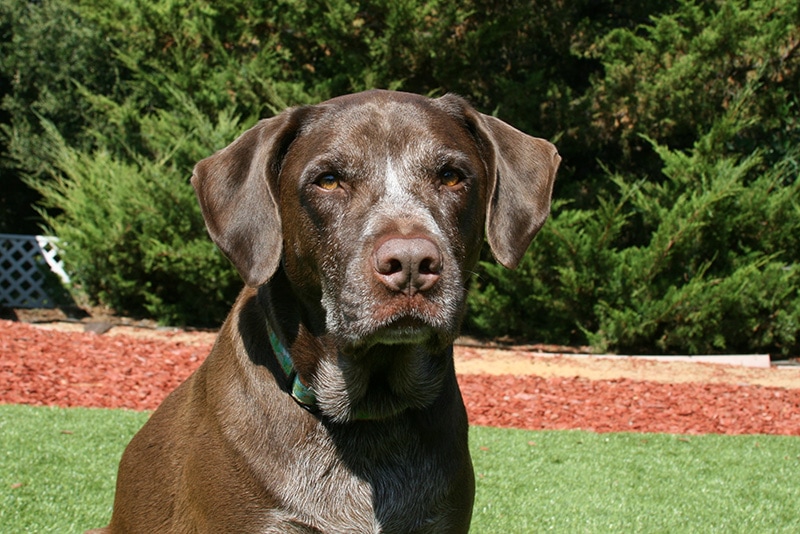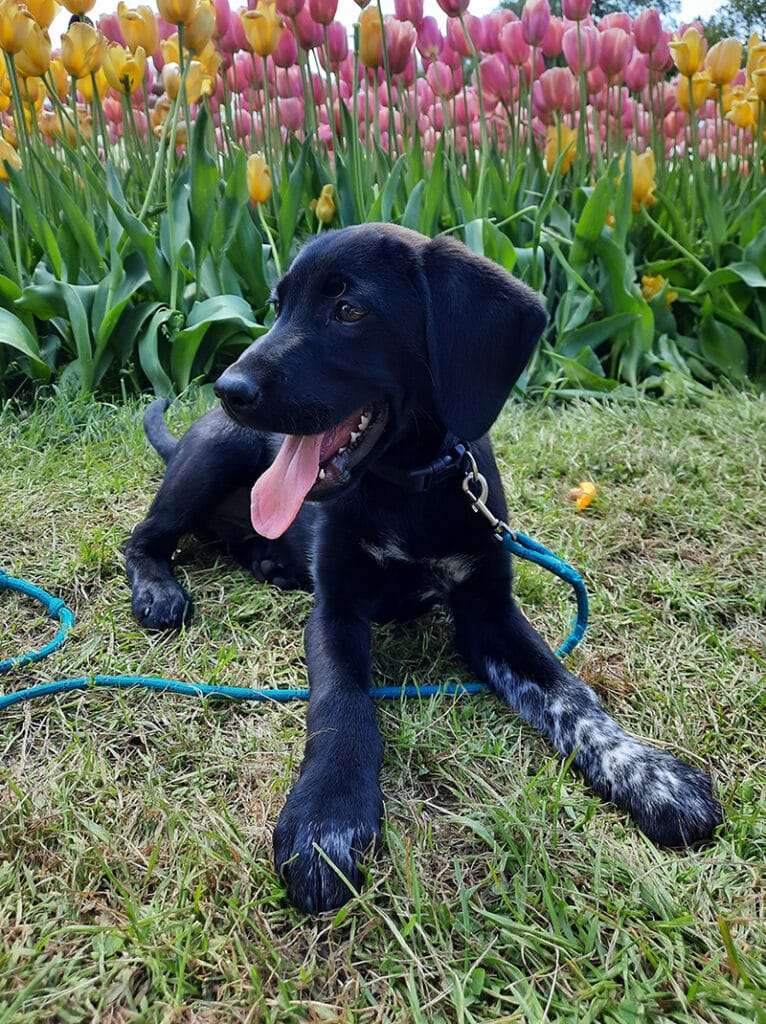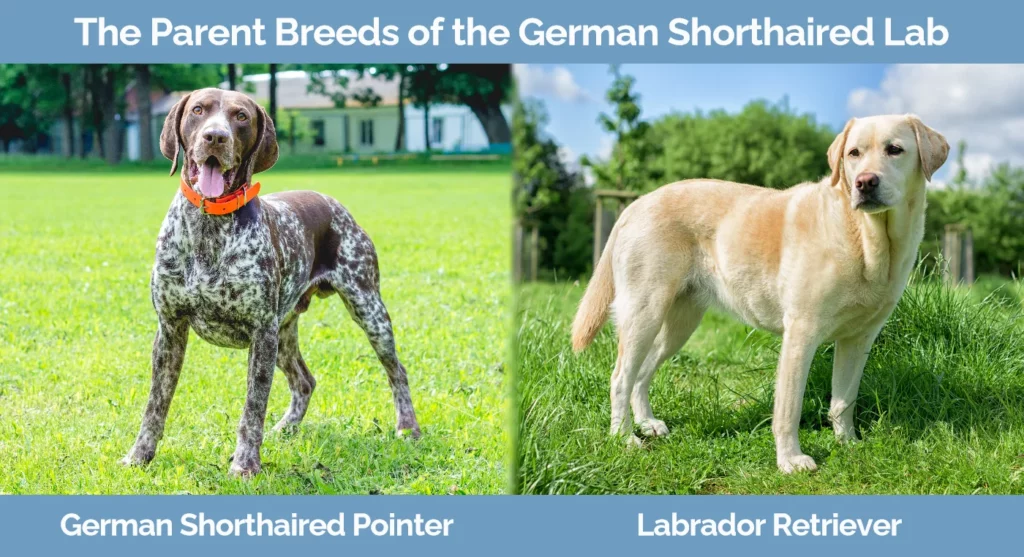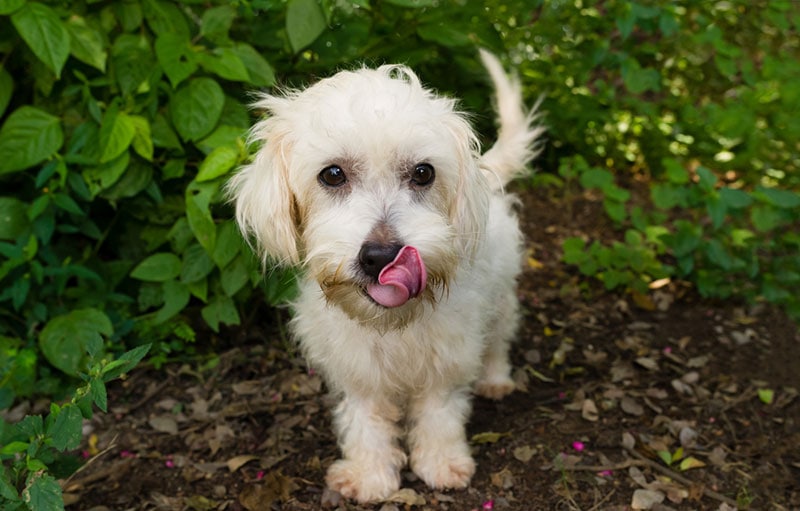German Shorthaired Lab (Lab & German Shorthaired Pointer Mix): Info, Pictures, Facts
By Grant Piper
Updated on

Click to Skip Ahead
Hybrid dogs and mixed breeds are more popular than ever before. In fact, mixed breed dogs are the most popular type of dog by overall numbers, and they far outstrip purebreds. Many mixed breeds are accidental mutts, but some of them are bred on purpose. The German Shorthaired Lab is one such dog. The German Shorthaired Lab is a combination of two of America’s most popular dogs, and the results are extremely encouraging. Here is everything you need to know about the German Shorthaired Lab mix.
Breed Overview
| Height: | 24–28 inches |
| Weight: | 55–80 pounds |
| Lifespan: | 10–12 years |
| Colors: | Red, Brown, White, Black, Liver, Liver and White, Black and White |
| Suitable for: | Active families looking for a dog they can spend a lot of time with both indoors and outdoors |
| Temperament: | Quick, loyal, eager to please, easy to train |
German Shorthaired Labs are a combination of a purebred Labrador Retriever and a purebred German Shorthaired Pointer. The history of the German Shorthaired Lab is murky, and there is no definite starting point for the mixed breed. Considering how popular and prevalent the Labrador Retriever and German Shorthaired Pointer are, there have likely been large numbers of German Shorthaired Labs on the streets or in the shelters, even if people don’t know exactly what they are. These dogs have excellent traits, are very versatile, and can be amazing companions for many years.
German Shorthaired Lab Characteristics
German Shorthaired Lab Puppies

German Shorthaired Labs are becoming more common, but they still are not the easiest to find. Unlike other mixed or hybrid breeds, this dog is recognized by a number of breeding organizations that work with mixed breeds. This means that there are more breeders familiar with German Shorthaired Labs that are more willing to breed them. Still, they will be more difficult to find, especially compared to common dogs like Golden Retrievers or Labrador Retrievers. You can always keep your eye out at the local shelter or with your local rescue groups. However, you might be able to find a breeder that is able to produce German Shorthaired Labs. Since German Shorthaired Labs are fairly large, they start out lanky and will become fully grown by 18 months of age.

Temperament & Intelligence of the German Shorthaired Lab
German Shorthaired Labs are driven by two primary characteristics. They are very smart, and they are very focused on people. This makes them easy to train and eager to please. However, it can also make them clingy and overly attached. Some German Shorthaired Labs suffer from separation anxiety, which can manifest in bad behaviors when you are not home or if you leave your dog for extended periods of time. When you are home, these dogs are ready to listen, ready to play, ready to cuddle, and ready to do pretty much whatever you want. These dogs are highly energetic and will need consistent mental and physical stimulation to be on their best behavior.
Are These Dogs Good for Families? 👪
Yes. German Shorthaired Labs can be fabulous family dogs. German Shorthaired Labs are highly trainable. They are very loyal, attached to their owners, snuggly, and loving. These dogs can do well with young kids and large families. The biggest issue with German Shorthaired Labs is going to be their exercise requirements (more on that below). These dogs require a lot of exercise, but as long as you can meet their daily needs, they can fit into almost any family unit.
Does This Breed Get Along With Other Pets? 🐶 😽
Yes. German Shorthaired Labs will be great with other pets. As hunting dogs, they could pose a problem for small animals like rabbits or birds. However, that can be easily remedied with training as long as you are aware that your German Shorthaired Lab could show predatory signs toward small animals. German Shorthaired Labs should get along fantastically with other dogs and even cats. Every dog is different, but these many German Shorthaired Labs are very friendly and open to playing with most other animals.
Things to Know When Owning a German Shorthaired Lab
Food & Diet Requirements 🦴
German Shorthaired Labs will need 3 to 4 cups of food per day. That can add up to quite a bit of money per month if you are not prepared for their level of hunger. German Shorthaired Labs can eat regular dry dog food. You might want to consider getting specialty food for your German Shorthaired Lab. Puppy food and food for active dogs could be beneficial when your German Shorthaired Lab is young. As your German Shorthaired Lab ages, you might want to consider putting them on food with a joint supplement in order to try to prevent any painful or degenerative joint problems. Do note that specialty foods can cost quite a bit more than standard dog foods.
Exercise 🐕
German Shorthaired Labs need a lot of exercise. These dogs are working dogs that are used to having a job. They can be incredibly energetic, especially if they are young. Experts recommend walking your German Shorthaired Lab for 90 to 120 minutes per day. That means two long walks per day, every day. They will also need some sort of mental stimulation in order to placate the parts of their brain used to having a job or goal. You can easily walk your German Shorthaired Lab for 10 to 15 miles per week, which is great for people who already exercise outside but could be a hindrance to people not prepared to give their dog the exercise it needs.
Training 🎾
German Shorthaired Labs get high marks for trainability. These dogs are generally eager to please, they respond well to positive reinforcement, and they can be trained in a number of different ways. German Shorthaired Labs can be hunting dogs, companion dogs, or even agility dogs. Training should start early, and German Shorthaired Labs should take well to obedience training and general training. With a plan, reinforcement, and consistency, you can quickly train your German Shorthaired Lab to fill a number of roles in your life.
The biggest hurdle to training your German Shorthaired Lab is going to be their energy levels. It can be hard to train dogs that are wired or overexcited. You will need to get your dog’s excess energy out before trying to do any consistent training. Young dogs can be hard to handle, especially if they are on the large side (75–85 pounds).
Grooming ✂️
German Shorthaired Labs do not need extensive grooming. They have a thick and coarse coat that can be oily. These dogs do not need professional grooming services to maintain their coat. However, German Shorthaired Labs can be prolific shedders. They will definitely shed twice per year (spring and autumn), but some German Shorthaired Labs will shed year-round. This can be frustrating. The best way to deal with shedding is to brush your dog once per week and give them regular baths to knock off dead fur before it falls out all over your furniture. You will need to keep an eye on your dog’s shedding levels and bathe them regularly, but they won’t need trims or cuts.
Health and Conditions 🏥
German Shorthaired Labs are generally healthy, but they do have some serious health concerns to be aware of. The two biggest health concerns are bloat and dysplasia. Bloat is a potentially fatal condition that can occur suddenly in large dogs like the German Shorthaired Lab. You need to know the signs of bloat and talk to your veterinarian about it, so you are not surprised if it happens. Dysplasia of the hips and elbows is another serious problem that can cause pain, arthritis, and mobility issues, especially as the dog ages. Dysplasia can be avoided by using a reputable breeder and screening for joint problems.
- Obesity
- Ear infection
- Skin allergies
- Bloat
- Entropion
- Hip Dysplasia
- Elbow Dysplasia
Male vs Female
There are very few differences between male and female German Shorthaired Labs (besides the obvious). Females are slightly smaller than males and slightly less energetic. Females are only a couple of inches shorter than males, but they can weigh 10 to 20 pounds less depending on their genetics and diet. Otherwise, the two sexes have very similar traits and personalities. If you want a smaller, calmer dog, you might want to consider getting a female German Shorthaired Lab.
3 Little-Known Facts About the German Shorthaired Lab
1. German Shorthaired Labs Combine Two Canine Favorites
If you haven’t heard of the German Shorthaired Lab, you have definitely heard of the two dogs that parent it. The Labrador Retriever is the 2nd most popular dog in the United States (and routinely comes in first as well), while the German Shorthaired Pointer is the 10th most popular dog in the United States. Combined, these two dogs average as the 6th most popular dog in the country. It is not surprising that the German Shorthaired Lab has so many great traits with parents like these.
2. German Shorthaired Labs Are Excellent Gun Dogs
Most people don’t think of Labrador Retrievers as gun dogs, but they are. Labs were bred to wait for the roar of a shotgun before swimming off to retrieve a duck (or other waterfowl). German Shorthaired Pointers are also gun dogs. That makes the German Shorthaired Lab an excellent gun dog. With two established gun dogs as parents, this dog can be a prime hunting dog.
3. German Shorthaired Labs Are Extremely Versatile
Due to their combination of genes, German Shorthaired Labs are extremely versatile dogs. They can be suited for a number of different jobs. They can have waterproof coats, they can be guard dogs, snuggly family dogs, hunting dogs, and exercise companions. These dogs are smart, athletic, and loyal. You can train them to do almost anything if you put your mind to it. That makes the German Shorthaired Labs one of the most versatile hybrid dogs available, especially compared to other designer breeds like Frenchtons or Golden Doodles.
Final Thoughts
German Shorthaired Labs combine two of America’s favorite dogs into one excellent package. They can be great family dogs for a large and busy family. They can be a primary hunting dog thanks to their gun dog pedigree. They can be athletic dogs for hunters, runners, or bikers. The Labrador Retriever and German Shorthaired Pointer are popular for a reason, and their hybrid offspring can be equally as popular.
Featured Image Credit: Sheryl Lynch, Shutterstock













